As the outdoor living trend continues to grow, finding the perfect decking material becomes essential for creating a stunning and functional outdoor space.
In this guide, we’ll explore the top 10 decking materials for 2023, highlighting their unique qualities, advantages, and considerations.
Whether you’re seeking low-maintenance options, natural aesthetics, or high durability, we’ve got you covered.
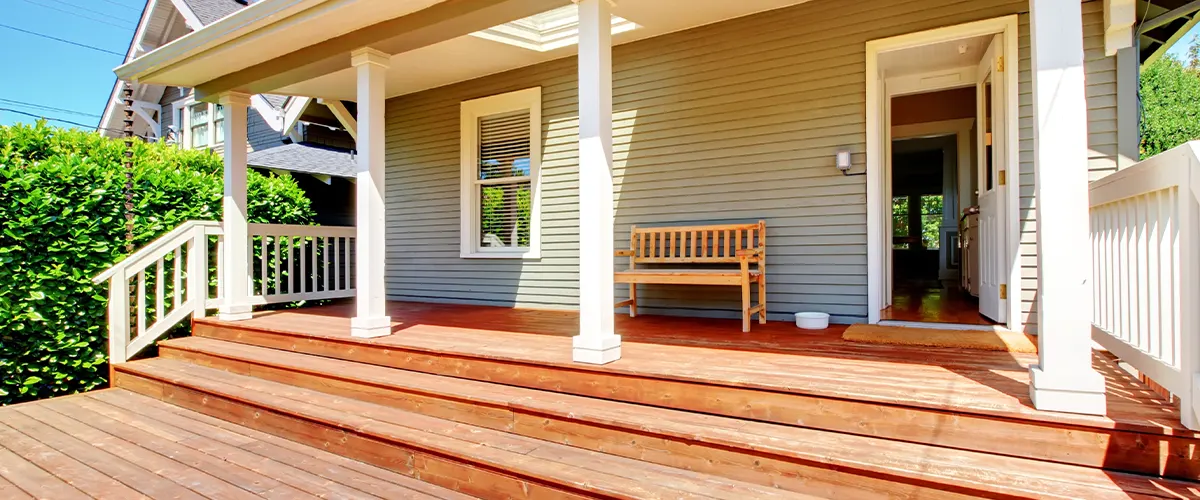
1. Composite Decking
Composite decking has risen to prominence for its impressive combination of aesthetics, durability, and sustainability.
It’s crafted by blending wood fibers and recycled plastics, offering the natural look of wood while being highly resistant to moisture, rot, and insect damage.
With minimal maintenance requirements, composite decking is an ideal choice for homeowners who desire the warmth of wood without constant upkeep.
Available in various wood grain patterns and colors, it allows for versatile design possibilities. Some of the best composite brands on the market these days are Trex, TimberTech, and Deckorators.
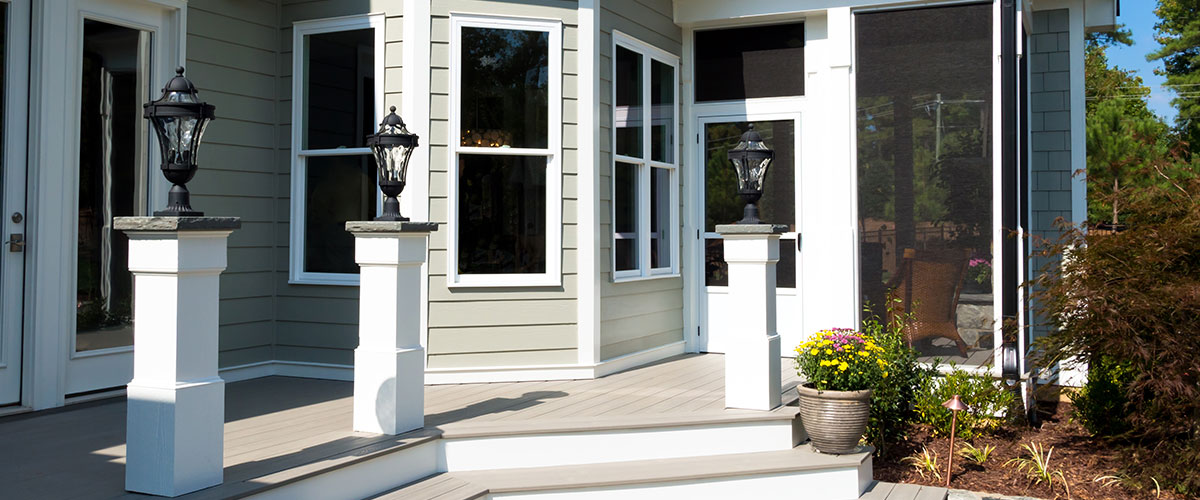
Pros and Cons of Composite Decking
| Pros | Cons | |
|---|---|---|
| Durability | Resistant to moisture, rot, and insects | Quality may vary among different brands |
| Low Maintenance | No staining or sealing required | Can have a higher upfront cost than wood |
| Design Versatility | Available in various colors and wood grain patterns | May lack the exact natural look of wood |
| Longevity | Resistant to fading, warping, and splintering | May get warm in direct sunlight |
| Sustainability | Made from recycled materials in some cases | Certain composites can scratch or stain |
| Installation | Easy to install with hidden fasteners | Quality may vary based on installation methods |
| Deck Maintenance | Minimal cleaning required | May show signs of wear over time |
2. Pressure Treated Wood
Pressure-treated wood remains a timeless and cost-effective choice for decking.
Through a pressure treatment process, the wood is infused with chemicals that ward off insects and decay, ensuring a long-lasting structure.
It’s an excellent option for those on a budget, yet it’s important to note that regular staining and sealing are necessary to maintain its appearance and structural integrity over time.
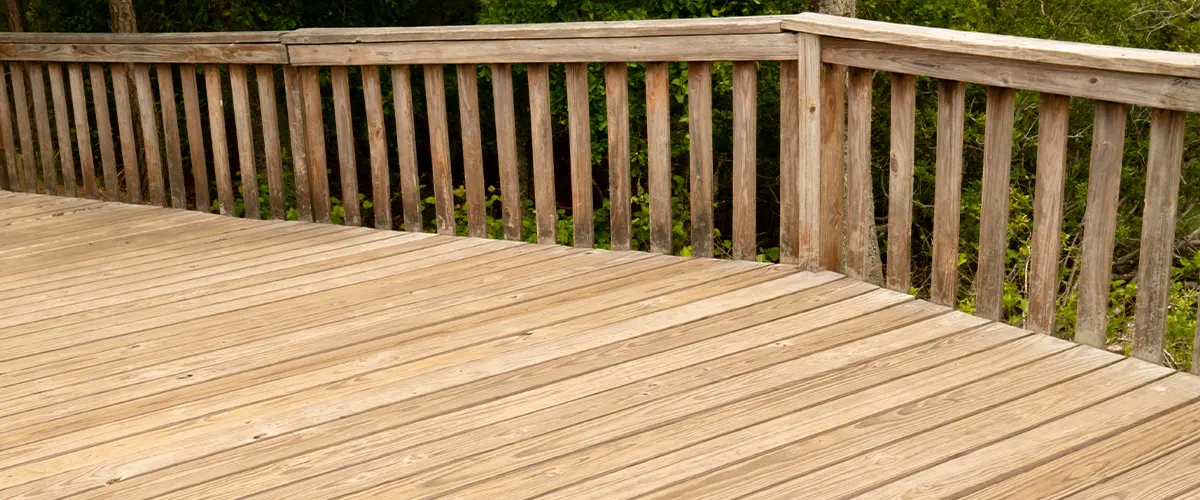
Pros and Cons of Pressure Treated Wood Decking
| Pros | Cons | |
|---|---|---|
| Cost-Effective | Budget-friendly option for decking | Requires regular staining and sealing |
| Durability | Resistant to decay and insect damage | May require periodic maintenance |
| Natural Aesthetics | Offers a classic wood appearance | Color may fade over time |
| Versatile Design | Accepts paint and stain for customization | May warp or splinter if not maintained |
| Availability | Readily available at most lumberyards | May not have the same longevity as other materials |
| Environmentally Friendly | Treated with environmentally safe preservatives | Requires ongoing care to prevent deterioration |
| Installation | Easy to work with and cut | May not have the same visual appeal as some alternatives |
3. PVC Decking
PVC decking, made from polyvinyl chloride, has gained popularity for its impressive durability and minimal maintenance needs.
Resistant to moisture, insects, and fading caused by direct sunlight, PVC boards stand strong against the elements. Additionally, they are available in a wide range of colors and styles, making them versatile for various design themes.
While PVC decking may have a higher upfront cost, its long-term benefits of being maintenance-free often outweigh the initial investment.

Pros and Cons of PVC Decking
| Pros | Cons | |
|---|---|---|
| Durability | Resistant to moisture, rot, and insects | Can be more expensive upfront |
| Low Maintenance | No staining, sealing, or painting required | May have a less natural appearance |
| Aesthetic Variety | Available in various colors and styles | Certain types may show scratches |
| Longevity | Resistant to fading, warping, and cracking | Can get warm under direct sunlight |
| Sustainability | Some products made from recycled materials | May not have the same texture as natural wood |
| Installation | Easy to install with hidden fasteners | Quality may vary based on installation |
| Weather Resistance | Suitable for various climates | Quality may vary among different brands |
4. Exotic Hardwoods
Exotic hardwoods provide an undeniable touch of luxury to any outdoor space.
These tropical hardwoods, like Ipe and Tigerwood, showcase rich colors and intricate grain patterns that can elevate the aesthetics of your deck.
While they are highly resistant to rot, insects, and natural tannins, they tend to be more expensive than other decking materials.
Additionally, their natural beauty requires more meticulous maintenance, including periodic oiling to preserve their luster and color.
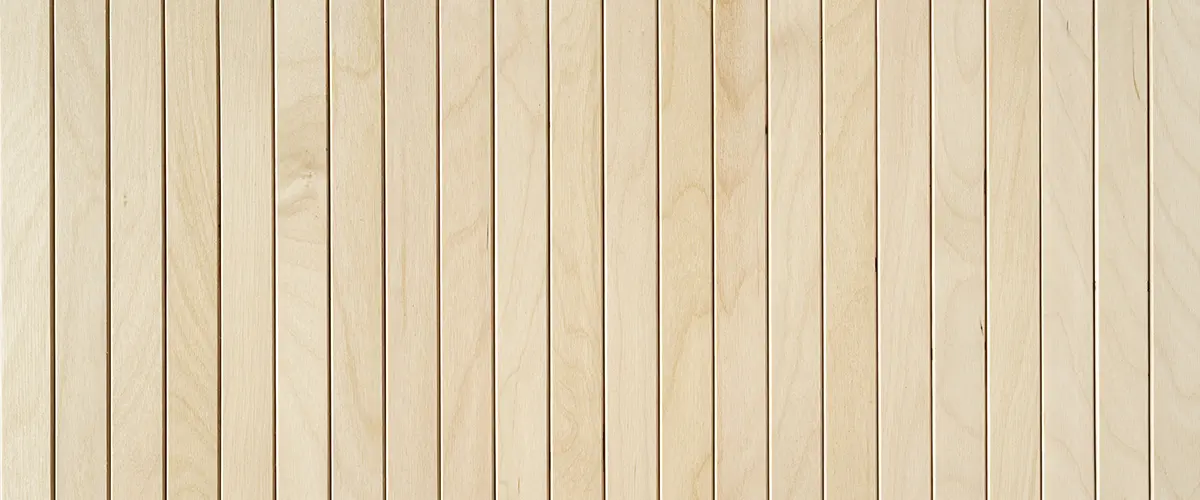
Pros and Cons of Exotic Hardwood Decking
| Pros | Cons | |
|---|---|---|
| Natural Beauty | Distinct colors and intricate grain patterns | Higher upfront cost compared to other materials |
| Durability | High resistance to decay, insects, and rot | Requires more meticulous maintenance |
| Luxurious Aesthetics | Elevates outdoor spaces with a touch of elegance | Natural beauty requires regular oiling and care |
| Longevity | Provides exceptional lifespan with proper care | Susceptible to color fading over time |
| Unique Appeal | Each exotic hardwood offers a distinctive look | May be limited by availability and cost |
| Resistant to Elements | Can withstand varying weather conditions | Prone to scratches and surface blemishes |
| Eco-Friendly Option | Sourced from sustainable forests | Requires regular maintenance for preservation |
5. Aluminum Decking
Aluminum decking is a modern and innovative choice that combines aesthetics with practicality.
Known for its high durability and fire resistance, aluminum decks are perfect for those seeking a deck material beyond traditional wood.
They are highly resistant to direct sunlight and provide an ideal solution for creating a deck in regions with varying weather conditions.
Minimal maintenance, coupled with their unique appearance, makes aluminum decks a compelling option.

Pros and Cons of Aluminum Decking
| Pros | Cons | |
|---|---|---|
| Durability | Highly durable and long-lasting | Can have a higher upfront cost |
| Fire Resistance | Excellent fire-resistant properties | May get hot in direct sunlight |
| Weather Resistance | Resistant to corrosion, rust, and weathering | Limited design versatility |
| Low Maintenance | Minimal maintenance requirements | May not offer the same warmth as wood |
| Modern Aesthetics | Sleek and contemporary appearance | Can have a less natural look compared to wood |
| Resistance to Elements | Suitable for various climates and coastal areas | May be noisy underfoot |
| Easy Installation | Simple installation process | May require specialized installation expertise |
6. Capped Composite Decking
Capped composite decking takes the advantages of composite materials a step further. It features an outer protective shell that enhances resistance to stains, scratches, and fading.
This added layer of protection makes capped composite decking an excellent choice for decks that experience heavy foot traffic or regular use.
With a variety of colors and wood grain patterns, capped composite decking offers the best of both worlds: the beauty of wood and the durability of modern materials.

Pros and Cons of Capped Composite Decking
| Pros | Cons | |
|---|---|---|
| Enhanced Durability | Resistant to moisture, rot, insects, and fading | May have a higher upfront cost |
| Low Maintenance | Requires minimal cleaning and no staining | Can be warmer under direct sunlight |
| Stunning Aesthetics | Available in a wide range of colors and patterns | May have a less natural appearance |
| Longevity | Offers superior resistance to wear and tear | May show signs of wear over time |
| Protection from Elements | Capped layer shields against stains and scratches | May be costlier than other composite options |
| Installation Ease | Easy installation with hidden fasteners | Quality may vary based on installation |
| Weather Resistance | Resistant to fading, warping, and cracking | May have a slightly synthetic texture |
7. Cedar Decking
Cedar decking is a timeless choice that delivers a naturally charming look. Its distinct wood grain and aroma create an inviting outdoor space.
Cedar is naturally resistant to decay and insects, thanks to its inherent oils and tannins.
However, regular maintenance is crucial to preserving its color and structural integrity. Homeowners who value the warm aesthetics of wood and are willing to commit to maintenance will find cedar decking to be a rewarding investment.
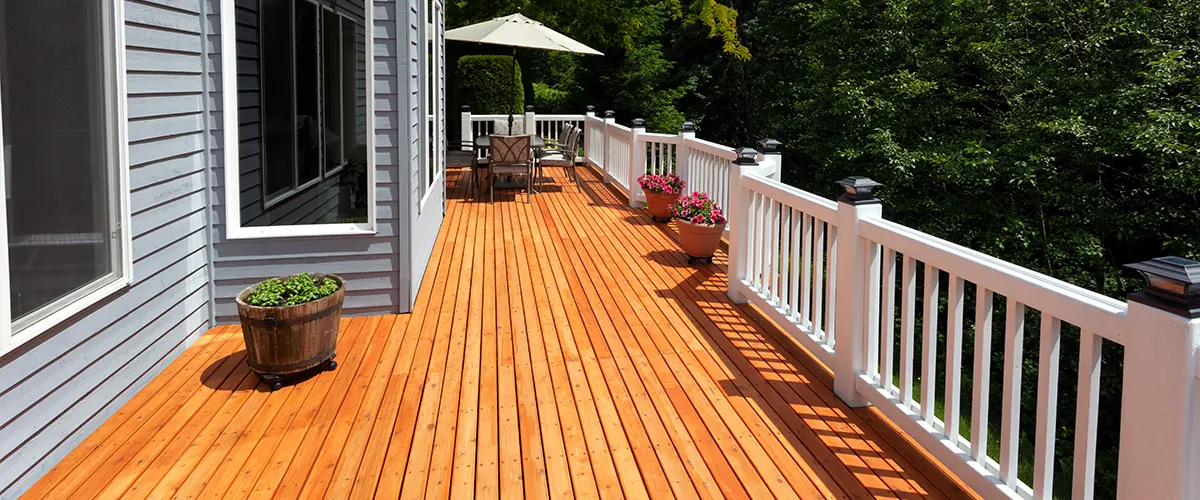
Pros and Cons of Cedar Decking
| Pros | Cons | |
|---|---|---|
| Natural Beauty | Distinct colors and pleasant aroma | Requires regular staining and sealing |
| Durability | Resistant to decay, rot, and insects | May require periodic maintenance |
| Warm Aesthetics | Warm and inviting appearance | May show signs of wear over time |
| Design Versatility | Accepts stain well for customization | May splinter if not properly maintained |
| Environmentally Friendly | Sustainable and renewable resource | May require more maintenance than some alternatives |
| Weather Resistance | Can withstand various climates | Natural color may fade over time |
| Affordability | Generally more affordable than some hardwoods | Susceptible to insect damage if untreated |
8. Pressure-Treated Wood Decking
Similar to pressure-treated lumber, pressure-treated wood decking is a reliable option for those who appreciate the traditional appearance of wood.
The pressure treatment process makes the wood resistant to decay and insects, ensuring durability.
However, like other wood decking materials, it requires regular maintenance in the form of staining and sealing to protect against wear and tear caused by foot traffic and the elements.

Pros and Cons of Pressure-Treated Wood Decking
| Pros | Cons | |
|---|---|---|
| Cost-Effective | Budget-friendly option for decking | Requires regular staining and sealing |
| Durability | Resistant to decay and insect damage | May require periodic maintenance |
| Natural Aesthetics | Offers a classic wood appearance | Color may fade over time |
| Versatile Design | Accepts paint and stain for customization | May warp or splinter if not maintained |
| Availability | Readily available at most lumberyards | May not have the same longevity as other materials |
| Environmentally Friendly | Treated with environmentally safe preservatives | Requires ongoing care to prevent deterioration |
| Installation | Easy to work with and cut | May not have the same visual appeal as some alternatives |
9. Uncapped Composite Decking
Uncapped composite decking offers a balance between cost-effectiveness and the benefits of composite materials.
While it lacks the outer protective layer of capped composite, it still provides resistance to moisture, rot, and insects. This option may require more maintenance over time due to exposure to the elements.
Homeowners interested in a more budget-friendly composite solution may find uncapped composite decking to be a suitable choice.
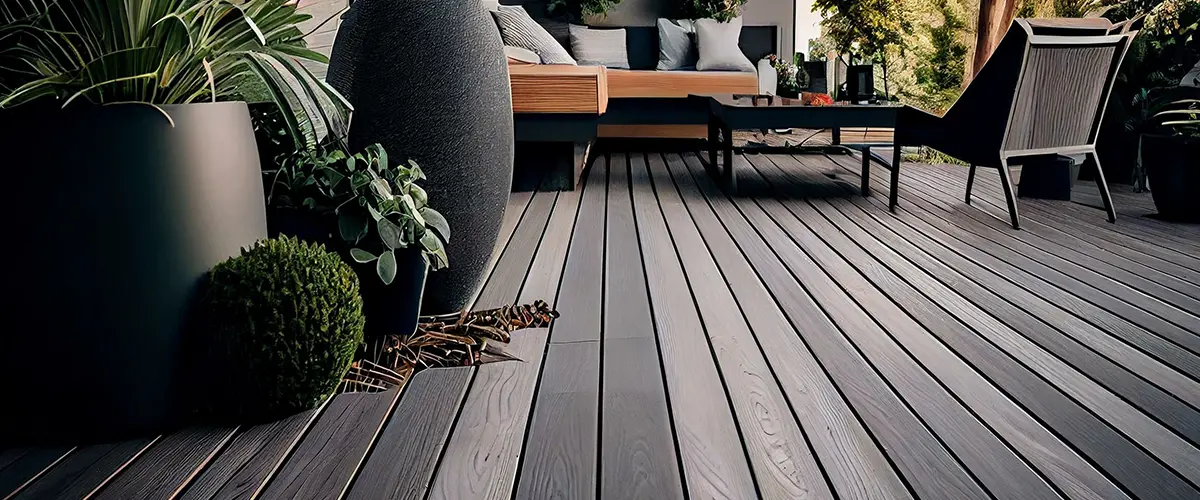
Pros and Cons of Uncapped Composite Decking
| Pros | Cons | |
|---|---|---|
| Durability | Resistant to moisture, rot, and insects | Prone to staining and fading over time |
| Low Maintenance | No sealing or painting required | May require more maintenance than capped options |
| Visual Appeal | Natural wood appearance with modern benefits | May show signs of wear and tear more quickly |
| Cost-Effective | Can be more affordable than capped composites | May be less resistant to fading and staining |
| Longevity | Generally offers good resistance to scratches | May require more maintenance than some other materials |
| Installation | Easy installation with hidden fasteners | Quality may vary based on installation |
| Design Versatility | Available in various colors and wood grains | May not have the same protective layer as capped options |
10. PVC Boards
Crafted from polyvinyl chloride, PVC boards provide a durable and low-maintenance solution for decking.
They are highly resistant to moisture, rot, insects, and fading caused by direct sunlight. With a variety of colors and styles, PVC boards offer the versatility needed to match your outdoor design preferences.
Whether you’re creating a relaxing retreat or an entertainment hub, PVC boards deliver durability without compromising on aesthetics.
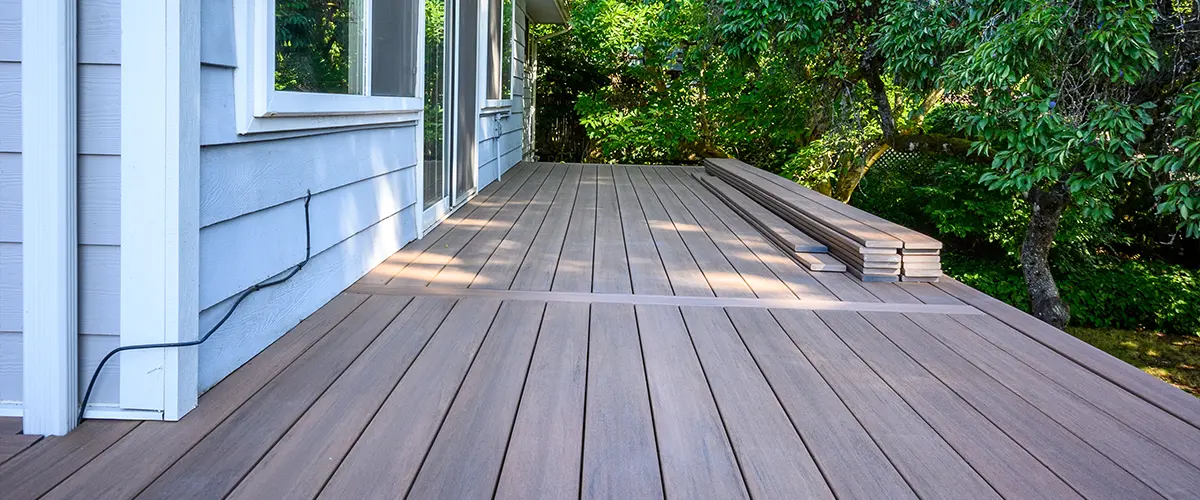
Pros and Cons of PVC Boards for Decking
| Pros | Cons | |
|---|---|---|
| Durability | Highly resistant to moisture, rot, and insects | May have a higher upfront cost |
| Low Maintenance | No staining, sealing, or painting required | May not have the same natural appearance |
| Aesthetic Variety | Available in various colors and styles | Certain types may show scratches |
| Longevity | Resistant to fading, warping, and cracking | Can get warm under direct sunlight |
| Sustainability | Some products made from recycled materials | May not have the same texture as natural wood |
| Installation | Easy to install with hidden fasteners | Quality may vary based on installation |
| Weather Resistance | Suitable for various climates | Quality may vary among different brands |
Best Materials For Decking FAQs
The best decking material for your project depends on several factors, including your budget, desired aesthetics, and maintenance preferences.
Traditional wood decking, such as natural wood or pressure treated lumber, provides a classic look that many homeowners appreciate. Alternatively, composite decking materials, which include composite deck boards, offer a blend of durability and low maintenance.
Consider your priorities, from the natural charm of wood to the longevity of composite materials, to determine the best fit for your needs.
Composite decking offers several advantages over traditional wood decking. While traditional wood decks have a charming appearance, they often require regular maintenance, such as staining and sealing, to prevent decay and insect damage.
On the other hand, composite decking materials, like composite deck boards, are designed to resist moisture, rot, insects, and fading.
They are also available in various colors and wood grain patterns, providing a long-lasting, low-maintenance solution that retains its beauty without the need for constant upkeep.
Composite decking materials may have a higher upfront cost per square foot than traditional wood decking.
However, it’s essential to consider the long-term costs and benefits. Composite decking requires minimal maintenance, eliminating the need for regular staining, sealing, and potential replacements due to wear and tear.
Over time, the savings on maintenance costs can balance out the initial investment, making composite decking a cost-effective choice for the future.
Yes, mixing and matching different decking materials can be an innovative way to create a unique and visually appealing deck design.
For example, you can combine traditional wood decking with composite deck boards to balance aesthetics and durability. Alternatively, you might use natural wood for the deck surface and composite materials for the deck frame to minimize maintenance.
Just ensure that the materials you choose are compatible and will provide the structural integrity required for your deck’s intended use.
Work With British Columbia Home Renovation Experts
When it comes to decking material, there are multiple factors you need to consider before making your decision. The material you choose should be based on your personal preferences and the practical considerations of your specific situation.
We’ve outlined six of the most popular decking material in this article, so you can make an informed decision about which one is right for you.
Remember that no matter which materials you choose, it’s vital to have a professional install your deck to ensure it’s built correctly and will last for years to come.
Here at City & Country Contracting, we take immense pride in our high-quality craftsmanship and a complete service that guarantees your satisfaction!
If you’re ready to get started on building a deck for your home in BC, give us a call at (604) 329-8996 or (250) 616-7700 or request a quote now!
